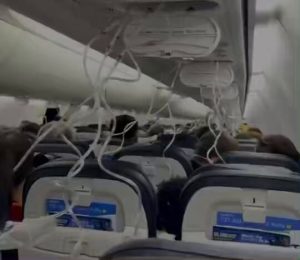In recent months, the Delhi-based airline SpiceJet has experienced mechanical difficulties with its fleet of aircraft. These incidents put the impacted aircraft’s passengers in danger and sparked concerns about SpiceJet’s fleet‘s condition. There were 13 similar occurrences in less than 10 months.
Also Read| Vistara’s engine fails just after Bangkok flight lands in Delhi; no casualties reported
How does turbulence affect an aeroplane and what does it mean?
A quick, unexpected shift in the pressure and velocity of the wind that can push or pull an aeroplane is referred to as turbulence.
Turbulence can cause minor shocks and strong, persistent shaking of the aircraft, which can sometimes result in very dangerous conditions.
Moderate turbulence has little effect on the aircraft’s balance, and the occupants endure relatively minor discomfort. Extreme turbulence can cause the aeroplane’s height and speed to vary rapidly.
Also Read| Fight or flight: How IndiGo staffers are using mass sick leaves to protest
Extreme turbulence may cause an aeroplane to shake violently, making flight management and stability challenges.
According to the Indian Express, there are at least seven main forms of turbulence. Typically, a plane would fly through a weather-related occurrence, such as a thunderstorm or dense cloud, which may generate turbulence.
Low-cost airlines
The Directorate General of Civil Aviation (DGCA) audited SpiceJet in September 2021 and discovered that the airline was suffering from a severe financial shortfall and that its maintenance methods were concerning.
Furthermore, in a show-cause letter delivered to SpiceJet on July 6, it noted that “SpiceJet has failed to produce safe, efficient, and dependable aviation services under Aircraft Rules, 1937.”
Also Read| Watch| Delhi-bound SpiceJet flight lands safely in Patna, smoke visible
It went on to say that it had uncovered that component suppliers were not being paid on time, resulting in a shortage of replacement parts.
According to Lenish Patel, Team Lead at aviation consultant CAPA (Center for Asia Pacific Aviation) India, “The financial crisis is a visible source of concern, and structural difficulties such as the recent ones cannot be avoided without a large recap. However, we must wait for SpiceJet to react to the show-cause notice before we can determine the gravity of the problem,” he said.
According to PTI, SpiceJet Chairman and Managing Director Ajay Singh has so far denied that the current difficulties were caused by a paucity of replacement components.
According to senior writer N Madhavan, in the age of low-cost carriers, aviation businesses are cutting costs, which looks to be affecting maintenance, as reported by The Quint. He noted that, despite the added pressure of the pandemic, most airlines have been operating within financial limitations.
Also Read| Why Tom Cruise’s flight scene in ‘Top Gun: Maverick’ cost $11,374 an hour
The policy of India for the maintenance, repair, and overhaul (MRO) industry
In September of last year, India’s civil aviation minister, Jyotiraditya Scindia, discussed several changes the government plans to make to the MRO business. He chastised India for accounting for barely 2.5% of the massive $80 billion global aviation repair business.
Some important changes to MRO policy to attract investment include:
-Rather than being assigned based on an entity’s request, land leasing will henceforth be done through open bids.
-Instead of the existing three to five years, land for MRO facilities would be provided for thirty years.
-Rather than the current system of the Airports Authority of India (AAI) setting rates, leasing rentals will be determined through a bidding process.
-Instead of the current 7.5 to 10% annual raise, the rate of lease rental escalation would be 15% every three years.
Also Read| New Air India CEO Campbell Wilson: 3 changes he could bring to airline
Begumpet, Bhopal, Chennai, Chandigarh, Delhi, Juhu in Mumbai, Kolkata, and Tirupati are among the eight AAI-run airports where MRO facilities would be established.
The ineffective DGCA
Although the airline’s financial problems appear to be the most significant issue, the DGCA’s indifference is a role.
“The DGCA typically only raises concerns after hearing a bad news article about probable accidents and engine problems”, said Prosenjit Datta, business and markets expert at Ernst & Young. He added – “This might be due to a personnel shortfall at the governing body, which hinders them from achieving all safety standards.”





